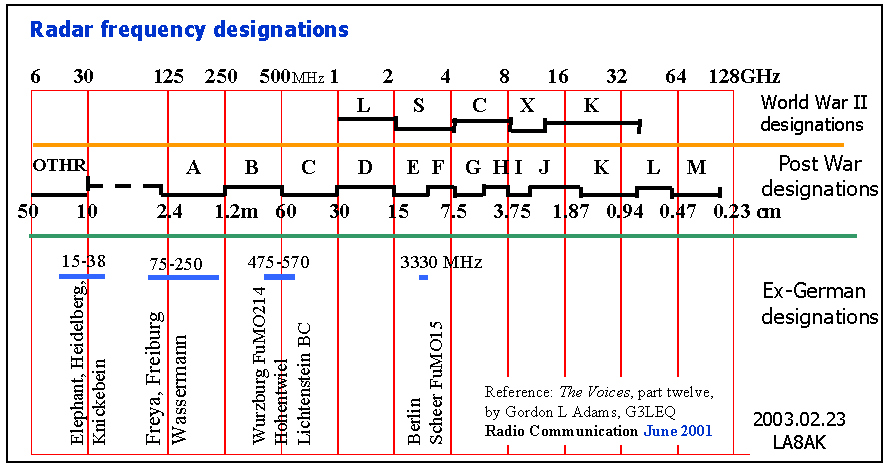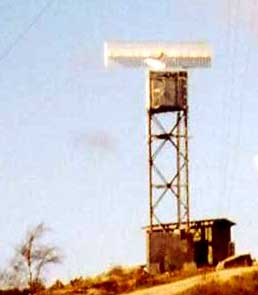
Tactical radar systems
written by Gordon L Adams G3LEQ, RSGB "Radcom", June 2001

Tactical radar systems
written by Gordon
L Adams G3LEQ, RSGB "Radcom", June 2001

To the original drawing I have added some reference to German
radar frequencies.
US FREEDOM OF INFORMATION ACT
BY 1974, the BBC - under the aegis of the Foreign Office - was
broadcasting its Etropean Service on
medium waves from a transmitter located on the Orford Ness
ex-OTHR site. For almost 20 years virtually
nothing has reached the public domain about the reason for the
Orford Ness OTHR closure. However,
between 1991 and 1993 an American body called the Defense
Advanced Research Projects Agency (DARPA)
did release details of an article about the 'Cobra Mist' radar
type ANIFPS-95 via a classified research journal,
JDR (Journal of Defense Research). This apparently became
officially declassified at the end of 1991,
under the provisions of the US Freedom of Information Act. There
is not sufficient space in RadCom to detail
the problems that arose at Orford Ness, but more information will
be given in a book version of 'The Voices'
that is due to be published before Christmas.
RUSSIAN 'CLUTTER'?
SUFFICE IT TO say that the 'Cobra Mist' radar system, which
was directed towards the Soviet Union,
was suffering from a form of 'clutter' interference. This
appeared to emanate from the targeted landmass,
and the possibility of Electronic Countermeasures (ECM) was not
ruled out. The system was intended,
of course, to detect Inter-Regional and Inter-Continental
Ballistic Missiles. In January 1973 a joint Scientific
Assessment Committee of US and UK experts was set up, and they
met between February and May of that
year to try and solve the performance degradation problem.
Amongst other things, they suggested that a pulse
compression system using a pulse length of 100 microseconds
should be installed. The Orford Ness OTHR
was using pulse widths of 250 to 3000 microseconds. Furthermore,
the in-tended power output of 10 Megawatts peak,
and 600 kilowatts average, had never been achieved due to
operating difficulties. These included electrical break-down,
or arcing, from the log-periodic antenna arrays. The equipment
was capable of frequency hopping in the range from
6 to 40MHz, but hunted around the Maximum Usable Frequency (MUF)
when in lull operational mode. In fact,
the power output level attained was never greater than 3.5MW peak
or 300kW average. The total power of the
Russian 'Woodpecker' from its four locations in
the Ukraine was claimed to be 400MW with pulse intervals of
100 milliseconds. Perhaps wisely, the US Air Force and the UK
Ministry of Defence decided not to continue with the
Orford Ness OTHR on 'economic' grounds.
For those not familiar with radar systems, the recent case of
the downed US Lockheed EP-3E Aries II spy plane,
which was forced to land on Hainan Island in China, comes to
mind. Besides their operating frequencies,
radar systems have very distinct operating characteristics, or
voices', which need to be recognised instantly
if appropriate Electronic Countermeasures are to be taken. Hence
the need for spy planes to provoke 'enemy'
systems into action, and then record their details for later
technical analysis. There are four basic categories of radar
system:
Continuous Wave (CW) radar,
where the transmitter output is a continuous, unmodulated, RF
oscillation.
Providing adequate screening between the transmitter and the
receiver is the main problem with this system,
and moving - rather than static - targets make the best quarries
by detecting the Doppler shift in the reflected signals or
echoes.
Frequency Modulated
Continuous Wave (FM-CW) radar, where
the carrier is modulated with a sinusoidal or
triangular waveform. By measuring the 'beat' or difference
frequency between the transmission and the echo, the
range of the target can be determined.
Basic Pulse radar,
as used in a 'Plan Position Indicator' (PPI) for air traffic
control and marine operations, where a
'bird's eye view' of the area covered appears on the radar
display (see
(Figure7). In
this type of system the 'Pulse Repetition Frequency' (PRF) is
particularly important, and this is normally
made as high as possible in order to avoid second time
scan-around echoes. Practical systems use pulse lengths
of 0.1 to 5 microseconds and often employ pulse compression.
Doppler shift measurements can only be made
during the period of the extremely short received pulse, but some
very effective 'Moving Target Indication' (MTI)
systems have been developed which discriminate between aircraft
and other moving objects.
Pulse Doppler radar
is a development of the Basic Pulse radar, which
eliminates speed assessment ambiguities,
by operating at much higher PRFs.
Most radio amateurs will associate radar systems with UHF and
Microwave frequencies (see Fig 8), and the UK
amateur licence does permit the use of pulse emissions above 1GHz
(1000MHz). Incidentally, I have not met any
radio amateurs who have made use of this facility. However, a new
range of commercial Personal Radars, using
Ultra Wide Band (UWB) technology is currently under development
in Huntsville, Alabama. Use of the HF
(short wave) portion of the radio frequency (RF) spectrum for
radar has the added feature of allowing propagation
substantially beyond the horizon. This occurs because the
ionosphere reflects or refracts the radar beam.
The resultant sky waves provide the basis of the over-the-horizon
radars, which can achieve ranges of thousands of kilometres.
The American Naval Research Laboratory (NRL) has developed a
Relocatable Over-the-Horizon Radar (ROHTR)
surface-to-surface HF system (ANITPS-71), which operates
typically over some 1 900km (see photo opposite).
HMS CYPRUS?
DURING THE LAST war, on 28 March 1941, a formidable naval
battle took place between the Italians and
British off the western end of Crete and to the south of the
Greek Cape Matapan - now called Cape Tainaron.
The outcome was a major success for the Royal Navy, and this also
settled the primacy of aircraft carriers over
battleships in future naval engagements. However, aircraft
carriers are extremely expensive, and can never be
built large enough to carry all the modern weapons of war. In
Part Seven of 'The Voices' (January 2001 RadCom)
I described the sudden conversion of the undercover British radio
station 'Sharq al-Adna', located at Polemidia to
the north-west of Limassol in Cyprus, to the 'Voice of Britain'.
This took place during the somewhat ill-fated Suez
campaign against Egypt in November 1956. However, by April 1957
Britain's new Prime Minister, Harold Macmillan,
was claiming that the island of Cyprus would decline in strategic
importance during the next 10 years. It rapidly became
apparent that he was wrong. Greece and Turkey, who were supposed
to be NATO allies, were constantly at odds with
each other over Cyprus, and at midnight on 15 August 1960 the
British officially handed over their responsibilities for
much of the island to the new Cypriot state. The UK government
retained a number of Sovereign Base Areas and various
other facilities outside these areas such as Cape Greko,
Dhekelia-Pergamos and Akrotiri Episkopi (see map opposite).
Throughout the Cold War, and right up to the present day,
Cyprus has proved to be a most important base for
top secret intelligence gathering. Since 1947 the UK has had an
intelligence agreement with the USA, Australia,
Canada and New Zealand, and the Americans operate all kinds of
electronic eavesdropping equipment on the island
at Mia Milia and Karavas. This involves radar, radio and other
electronic systems to intercept both Russian and
Middle Eastern signals. They can also track the heat emissions of
aircraft and missiles as they take off.
These operations are manned by the Joint Service Signal Unit
(JSSU Agios Nikolaos), which now embodies the
2nd Special Wireless Regiment and the 9th Signal Regiment of the
Royal Signals and the 33 Signal Unit RAF.
Much of the intercepted encrypted traffic is sent back by
microwave link to GCHQ in Cheltenham. At the peak of
the Cold War British signals intelligence involved some 20,000
people world-wide, daily handling tens of thousands
of classified documents, with a tidy proportion emanating from
Cyprus.
The facilities on Cyprus include OTHR radar installations,
currently to be heard on HF operating between about
10MHz and 27MHz, and always close to the local MUF. During the
major outbreak of fighting on Cyprus in 1974,
heavy military protection had to be given to the RAF radar
installations on Mount Olympos in the Troodos mountain range.
This system operates over a span of 1500 to 3000 kilometres, and
can reach twice that distance via double-hop ionospheric
propagation. Other similar systems are to be found in Turkey, in
and around the large military base at Incirlik,
protecting NATO'S south-eastern flank.
Cyprus has been likened to an unsinkable aircraft carrier.
Sadly, it has been divided across the middle since 1974
by the Attila or Green Line, which separates the Turkish-Cypriot
community in the north and the Greek-Cypriot community
in the south. On the eastern side of the island, the British base
of Agios Nikolaos accommodates a massive aerial farm -
overlooking the largely deserted town of Famagusta. Tourist boats
from the Greek side take holiday-makers into
Ammochostos Bay, but they are not allowed to land. Who knows,
they might even end up glowing in the dark if they approach too
close!
OMINOUS THREATS
OTHERS ARE, of course, interested in all this technology. In
April 1998 the Israeli air force was accused of
sending spy planes into Cypriot 'radar airspace'. The following
month a suggestion was made in the press that the
Russians would be able to control the region using a type
S-300PMU-l TMD strategic air defence system that they
were selling to the government of Cyprus.
Read about German WWII radar
systems in this area (South Norway)

A modern version of Freya, still in use several places in the
country - as secondary radars on 1GHz, but they are so-called IFF
for civil aviation

Last update: 2005.03.24